ASUS P8Z77-V Premium Review: A Bentley Among Motherboards
by Ian Cutress on August 13, 2012 10:30 AM EST- Posted in
- Motherboards
- Asus
- Z77
Gaming Benchmarks: A note on Multi GPU and PLX PEX 8747
In an upcoming review, we will go into detail regarding the PLX PEX 8747 chip on motherboards. This chip allows the manufacturers to adjust lane counts between PCIe slots, and increase bandwidth between PCIe slots at the expense of added latency to the CPU. Normally the Z77 chipset is limited to x8/x4/x4 in multi-GPU setups, but with the PLX chip this is expanded, such that x8/x8/x8/x8 in PCIe 3.0 is available. There is more under the hood than this, especially relative to performance, but it is important to note for this review and results where we are comparing many setups. Out of the boards we have tested, the configurations are below.
| PCIe Comparison Chart | ||||||
| Chipset | Motherboard | GPUs | GPU 1 | GPU 2 | GPU 3 | GPU 4 |
| X79 | Rampage IV F/E | 1 |
16x PCIe 2.0 from CPU |
|||
| X79 | Rampage IV F/E | 2 |
16x PCIe 2.0 from CPU |
16x PCIe 2.0 from CPU |
||
| X79 | Rampage IV F/E | 3 |
16x PCIe 2.0 from CPU |
16x PCIe 2.0 from CPU |
8x PCIe 2.0 from CPU |
|
| X79 | Rampage IV F/E | 4 |
16x PCIe 2.0 from CPU |
8x PCIe 2.0 from CPU |
8x PCIe 2.0 from CPU |
8x PCIe 2.0 from CPU |
| Z77 | Any | 1 |
16x PCIe 3.0 from CPU |
|||
| Z77 | Most | 2 |
8x PCIe 3.0 from CPU |
8x PCIe 3.0 from CPU |
||
| Z77 | Few | 2 |
16x PCIe 3.0 from CPU |
4x PCIe 2.0 from Z77 |
||
| Z77 |
Gigabyte Z77X-UD5H |
3 |
8x PCIe 3.0 from CPU |
4x PCIe 3.0 from CPU |
4x PCIe 3.0 from CPU |
|
| Z77 |
Biostar TZ77XE4 |
3 |
8x PCIe 3.0 from CPU |
8x PCIe 3.0 from CPU |
4x PCIe 2.0 from Z77 |
|
| Z77 |
ASUS P8Z77-V Premium |
3 |
16x PCIe 3.0 from PLX |
8x PCIe 3.0 from PLX |
8x PCIe 3.0 from PLX |
|
| Z77 |
ASUS P8Z77-V Premium |
4 |
8x PCIe 3.0 from PLX |
8x PCIe 3.0 from PLX |
8x PCIe 3.0 from PLX |
8x PCIe 3.0 from PLX |
In general:
PCIe 3.0 > PCIe 2.0
Lanes from CPU > Lanes from PLX > Lanes from Chipset
More lanes > Less lanes
Civilization V
Civilization V is a strategy video game that utilizes a significant number of the latest GPU features and software advances. Using the in-game benchmark, we run Civilization V at 2560x1440 with full graphical settings, similar to Ryan in his GPU testing functionality. Results reported by the benchmark are the total number of frames in sixty seconds, which we normalize to frames per second.
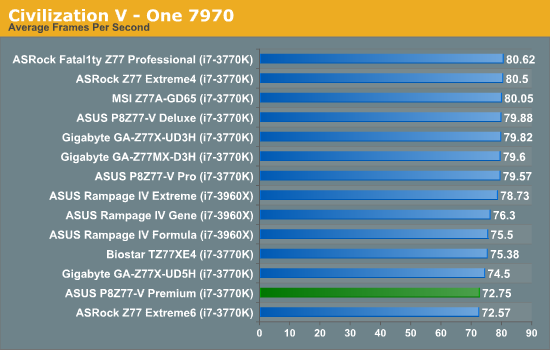
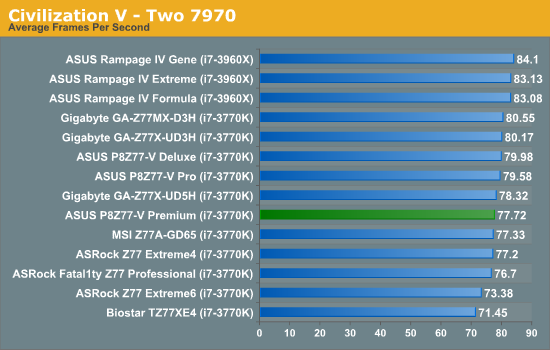
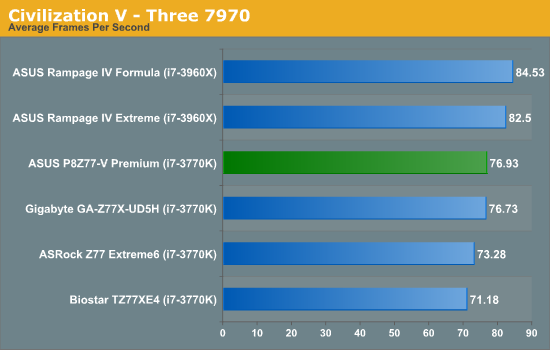
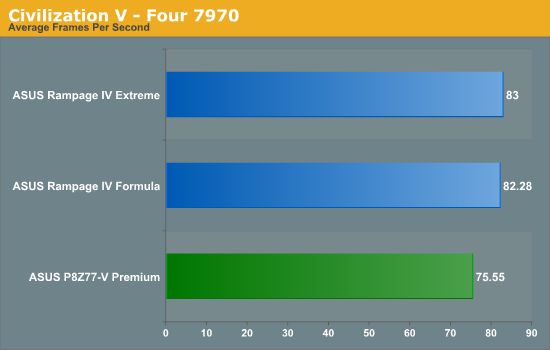
Civilization V is unfortunately a bad game to see scaling with our 7970 cards, especially as we are locked in with our drivers during our Z77 testing. At each test, the Premium scores above 70 FPS, but falls a little in single GPU testing compared to others hitting 80 FPS.
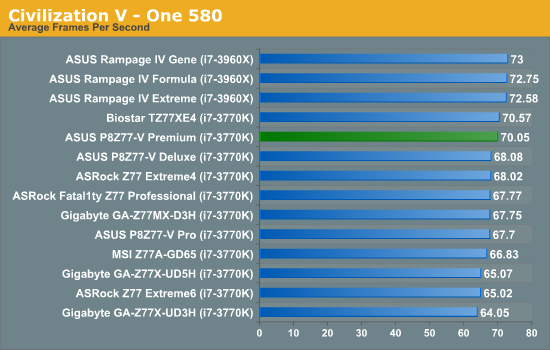

Civilization V scales a little bit better on NVIDIA cards, giving a near top Z77 result in single mode, but is middle of the pack in dual GPU mode.
Dirt 3
Dirt 3 is a rallying video game and the third in the Dirt series of the Colin McRae Rally series, developed and published by Codemasters. Using the in game benchmark, Dirt 3 is run at 2560x1440 with full graphical settings. Results are reported as the average frame rate across four runs.
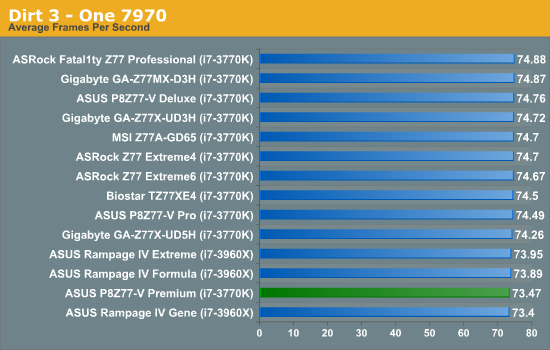
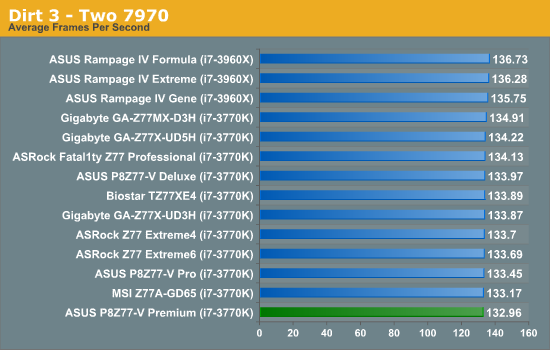
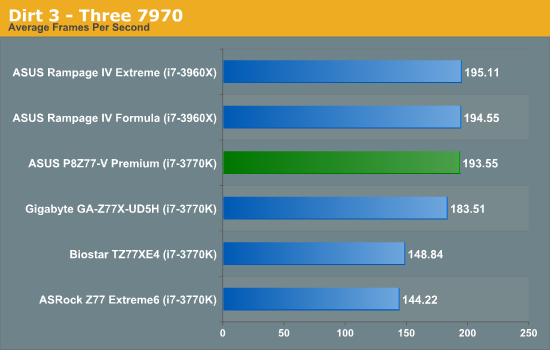
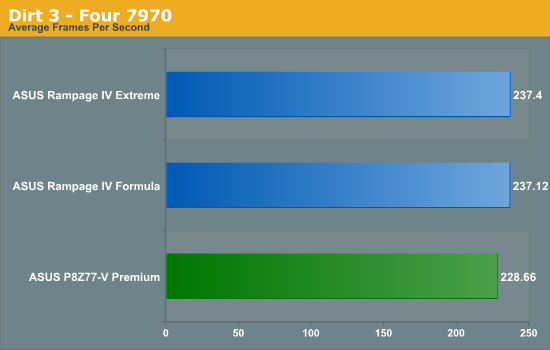
Dirt 3 loves GPU power, and it is not until we hit three GPUs where the difference in lane counts come into play. In our three-GPU testing, the Rampage IV Formula gets 194.55 FPS, the Premium is 193.55 FPS and the GA-Z77X-UD5H is 183.51 FPS. The latter two have similar CPU speeds but differ on lane count, giving the Premium an extra 10 FPS.

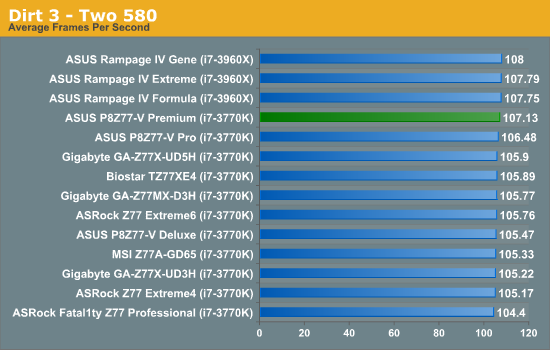
Not much to say for Dirt 3 + NVIDIA testing, all the motherboards perform roughly the same.
Metro2033
Metro2033 is a DX11 benchmark that challenges every system that tries to run it at any high-end settings. Developed by 4A Games and released in March 2010, we use the inbuilt DirectX 11 Frontline benchmark to test the hardware at 2560x1440 with full graphical settings. Results are given as the average frame rate from 4 runs.
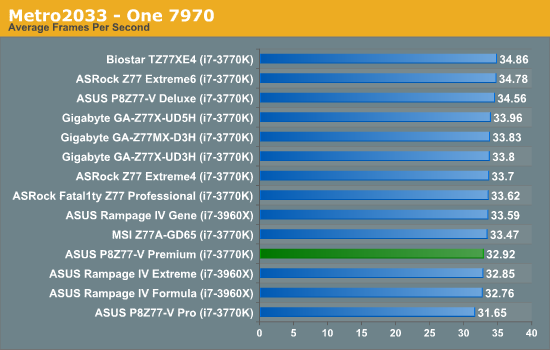
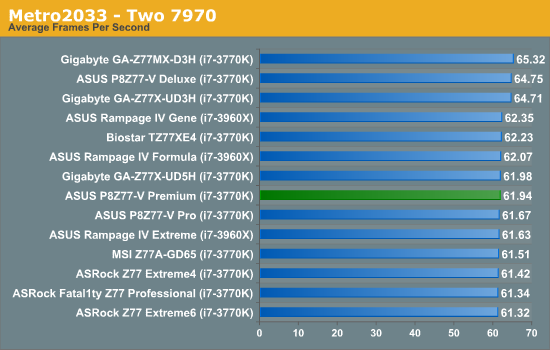
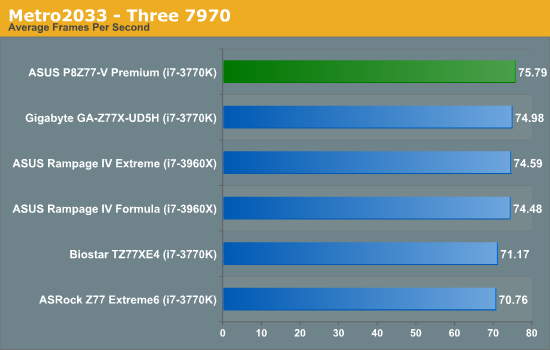
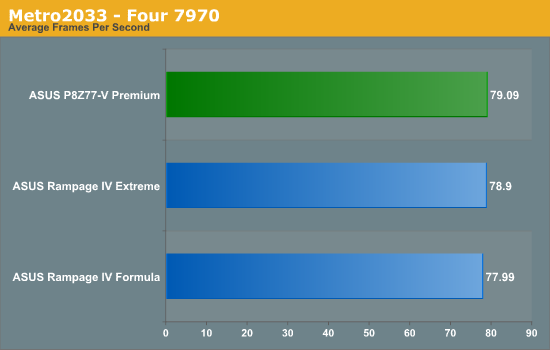
In Metro 2033 + AMD, all the motherboards perform similarly in single and dual GPU mode, but at tri-GPU mode the Premium takes almost a 1 FPS advantage over the nearest challenger.
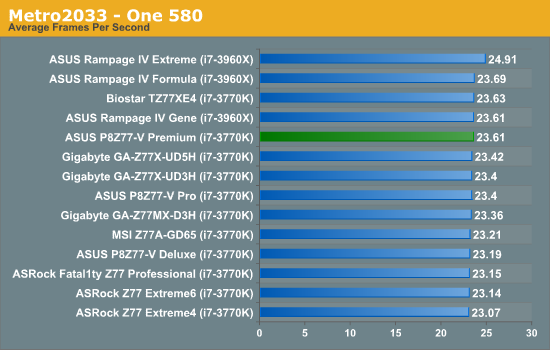

With Metro 2033 + NVIDIA, all the motherboards perform similarly in single and dual GPU.










43 Comments
View All Comments
Phynaz - Monday, August 13, 2012 - link
And so are the handful of people that would spend $450 on a motherboard.Samus - Tuesday, August 14, 2012 - link
I spent $300 on my Asus P6T (socket 1366) in December 08. I still use it today, only upgrading it with a USB 3.0 PCIe card and from a GTX285 to a GTX570, keeping it 'current'.The i7-950 and 12GB of triple-channel DDR3 keep it competitive with the upper 90% of computers made today, so I feel it was a completely worthy investment.
Who else can honestly say they've had a computer for four years and have upgraded virtually nothing aside from the video card and still have performance competitive with the fastest computers sold today?
Visual - Tuesday, August 14, 2012 - link
Um, pretty much everyone that bought any kind of quad core?Mobo has always had almost zero effect on performance to begin with, CPUs have been faster than most people need them be in the last decade or so, GPU is the only thing that matters.
This mobo is not expencive because it has any pluses in performance, but because of the extra frills and features it has... which are only worth it if you actually use them. I don't think I will need most of them currently, and can add them on to any computer if I decide to use them later on. So this mobo is not worth it for me.
pandemonium - Thursday, August 16, 2012 - link
This is pretty silly, since A LOT rides on which CPU you're using and how overclocked it is. GPUs are DEFINITELY NOT the only thing that matters and this has been proven through hundreds of reviews and comparisons all over the net.BytesMage - Tuesday, September 11, 2012 - link
Never crazy. My last build was 4 years ago. 790i SLI Ultra. I've kept him alive with GPU upgrades from 9800Gx2 in 2008 to GTX 580 3gb x2 in 2011, Memory upgrades from 4gb to 8gb. This extends life yes, but you get to the point of no return and then have to build again. I am at that place now. Mobo is very important. It is the ground floor on which everything else must stand. I have had a bad Mobo in past and can tell you that it does not matter what GPU you have if your mobo is poo. I want a feature rich, stable, OC able board with plenty of room for expansion. Price is what you pay for this. Well worth it. Why is it that no one moans (much) at $600.00 GPu but they do at $450.00 MB???? It is what it is. Where I see bad pricing is SSDs $500-600 big ones for a 512gb....Menetlaus - Monday, August 13, 2012 - link
I don't understand the inclusion of the 32GB mSATA SSD with this motherboard, even more so at the $450 price point.As the article says, anyone paying that kind of cash can easily afford a bigger and faster SSD and the 32GB is barely enough for a Win 7 install. The only way I really see it being beneficial is if it came pre-configured to work as cache (using intel rapid storage tech or similar) but there would be no way for them to know which drive to speed up as there is no point in caching a fast SSD if one was installed as the OS drive.
I really like that is has a mSATA port to allow a user to install a small form SSD, but including a 32GB drive these days is simply too small for a standalone drive and the configuration to get intel RST or similar working is not for the novice user (or so I've heard).
cjs150 - Monday, August 13, 2012 - link
I agree the mSATA seems a frivolous extra although I would give two reasons; 1. Not big enough, 128Gb mSATA would be nice though 2. only SATA 3G, the latest mSATA cards are SATA 6G but sadly not got a board to support this yet.If this is a true premium board mSATA should be SATA 6G then it would be truely quick
ASUSTechMKT - Tuesday, August 14, 2012 - link
the current mSATA spec only supports 3G as it is required to be linked to the 3G PCH port per Intel specification. Additionally see the feedback above regarding the 32GB mSATA module. Lastly a larger capacity mSATA would have considerably increased the cost which was already high especially considering all the logic some covered and some not covered in the review.Also would not in our analysis overall usage of mSATA is very low for users in the desktop space due to higher cost compared to standard 2.5inch SSDs. This is also why we integrated the solution to ensure a fully usable out of box solution for SSD caching.
AnnihilatorX - Monday, August 13, 2012 - link
The 32GB SSD may be aimed at the Intel Smart Response SSD Caching Technology for a larger mechanical HDD.One may also use it for a Linux partition I guess?
If I am to buy this, I may sell the mSATA. I wonder how much that will fetch.
Azethoth - Monday, August 13, 2012 - link
Yeah, I added a REVODRIVE 3 X2 (240GB SSD) to my Z77 build. It cost about as much as this motherboard but it doesn't need a puny 32GB cache to slow it down. My media is already on a NAS so 240GB is all I need for OS, software development and games.However next year I will definitely buy the premium LGA 2011 version, hopefully it comes with a 64GB SSD so I can add a backup drive under it.